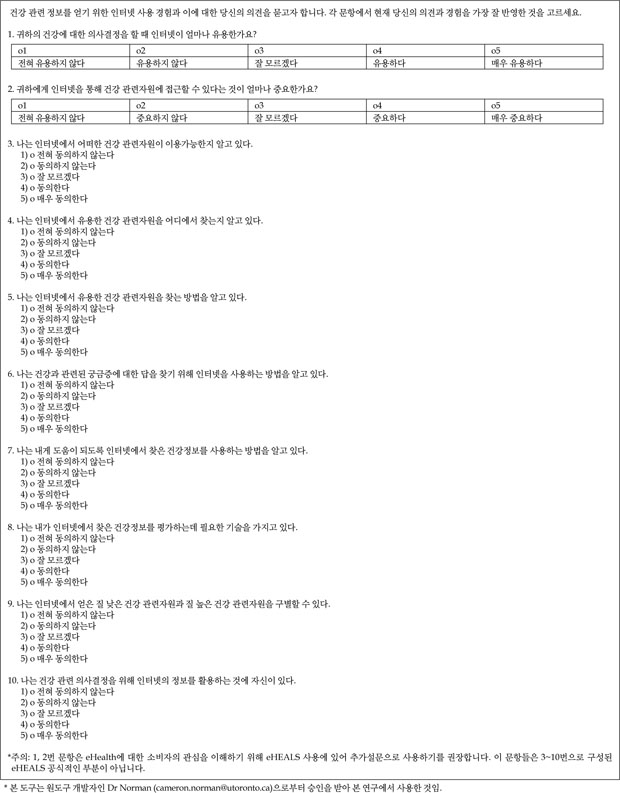1. Berkman ND, Davis TC, MaCormack L. Health literacy: what is it? J Health Commun. 2010; 15:Suppl 2. 9–19. DOI:
10.1080/10810730.2010.499985.

2. DeMarco J, Nystrom M. The important of health literacy in patient education. J Consum Health Internet. 2010; 14(3):294–301. DOI:
10.1080/15398285.2010.502021.
3. Kim S, Oh J, Lee Y. Health literacy: an evolutionary concept analysis. J Korean Acad Soc Nurs Educ. 2013; 19(4):558–570. DOI:
10.5977/jkasne.2013.19.4.558.

4. Cutrona SL, Mazor KM, Vieux SN, Luger TM, Volkman JE, Finney Rutten LJ. Health information-seeking on behalf of others: characteristics of “surrogate seekers”. J Cancer Educ. 2015; 30(1):12–19. DOI:
10.1007/s13187-014-0701-3.

6. Tonsaker T, Bartlett G, Trpkov C. Health information on the internet. Gold mine or minefield? Can Fam Physician. 2014; 60(5):407–408.
7. Park DJ, Kwon MS, Choi J. The influence of health information orientation, attitudes of internet health information, and e-Health literacy on personal health behaviors. J Public Relat Res. 2013; 17(3):379–413. DOI:
10.15814/jpr.2013.17.3.379.
8. Stellefson M, Hanik B, Chaney B, Chaney D, Tennant B, Chavarria EA. eHealth literacy among college students: a systematic review with implications for eHealth education. J Med Internet Res. 2011; 13(4):e102. DOI:
10.2196/jmir.1703.

9. Norman CD, Skinner HA. eHEALS: the eHealth Literacy Scale. J Med Internet Res. 2006; 8(4):e27. DOI:
10.2196/jmir.8.4.e27.

10. Paramio Pérez G, Almagro BJ, Hernando Gómez Á, Aguaded Gómez JI. Validation of the eHealth Literacy Scale (eHEALS) in Spanish university students. Rev Esp Salud Publica. 2015; 89(3):329–338. DOI:
10.4321/S1135-57272015000300010.
11. De Caro W, Corvo E, Marucci AR, Mitello L, Lancia L, Sansoni J. eHealth Literacy Scale: an nursing analysis and Italian validation. Stud Health Technol Inform. 2016; 225:949.
12. Koo M, Norman C, Chang HM. Psychometric evaluation of a Chinese version of the eHealth Literacy Scale (eHEALS) in school age children. Int Electron J Health Educ. 2012; 15:29–36.
13. van der Vaart R, Drossaert C. Development of the Digital Health Literacy Instrument: measuring a broad spectrum of health 1.0 and health 2.0 skills. J Med Internet Res. 2017; 19(1):e27. DOI:
10.2196/jmir.6709.

14. Kim JO, Park JK. The reliability of health information on the internet and the medical advertising's attitudes on the internet according to e-Health literacy level. J Humanit Soc Sci 21. 2017; 8(4):299–314. DOI:
10.22143/HSS21.8.4.17.
15. Lee BK, Byoun WJ, Lim JL. The influence of individual's e-Health literacy on doctor-patient communication. J Cybercommunication. 2010; 27(3):89–125.
17. Park JH, Kwon YH. Standardization of Korean version of the Mini-Mental State Examination (MMSE-K) for use in the elderly part II diagnostic validity. J Korean Neuropsychiatr Assoc. 1989; 28(3):508–513.
18. Polit DF, Beck CT. Nursing research: generating and assessing evidence for nursing practice. 9th ed. Philadelphia, PA: Lippincott Williams & Wilkins;2012.
19. Kline RB. Principle and practice of structural equation modeling. New York: Guilford Press;2005.
20. Park MS, Kang KJ, Jang SJ, Lee JY, Chang SJ. Evaluating test-retest reliability in patient-reported outcome measures for older people: a systematic review. Int J Nurs Stud. 2018; 79:58–69. DOI:
10.1016/j.ijnurstu.2017.11.003.

21. Zulman DK, Kirch M, Zheng K, An LC. Trust in the internet as a health resource among older adults: analysis of data from a nationally representative survey. J Med Internet Res. 2011; 13(1):e19. DOI:
10.2196/jmir.1552.

22. Paige SR, Krieger JL, Stellefson ML. The influence of eHealth literacy on perceived trust in online health communication channels and sources. J Health Commun. 2017; 22(1):53–65. DOI:
10.1080/10810730.2016.1250846.

23. Jung WS, Kang HG, Suk MH, Kim EH. The use of the internet health information for the elderly. J Korean Public Health Nurs. 2011; 25(1):48–60.
24. Chang SJ, Im EO. A path analysis of internet health information seeking behaviors among older adults. Geriatr Nurs. 2014; 35(2):137–141. DOI:
10.1016/j.gerinurse.2013.11.005.

26. Hair JF, Black WC, Babin BJ, Anderson RE. Multivariate data analysis. 7th ed (Pearson new international edition). Essex: Pearson Education Limited;2014.
27. Bae BL. Structural equation modeling with AMOS 17.0. Seoul: Cheongram Books;2009.
28. Neter E, Brainin E. eHealth literacy: extending the digital divide to the realm of health information. J Med Internet Res. 2012; 14(1):e19. DOI:
10.2196/jmir.1619.

29. Richtering SS, Morris R, Soh SE, Barker A, Bampi F, Neubeck L, et al. Examination of an eHealth Literacy Scale and a health literacy scale in a population with moderate to high cardiovascular risk: Rasch analysis. PLoS ONE. 2017; 12(4):e0175372. DOI:
10.1371/journal.pone.0175372.
30. Peterson RA. A meta-analysis of variance accounted for and factor loading in exploratory factor analysis. Mark Lett. 2000; 11(3):261–275.
31. Kang H. A guide on the use of factor analysis in the assessment of construct validity. J Korean Acad Nurs. 2013; 43(5):587–594. DOI:
10.4040/jkan.2013.43.5.587.

32. Fitzpatrick R, Davey C, Buxton MJ, Jones DR. Evaluating patient-based outcome measures for use in clinical trials. Health Technol Assess. 1998; 2(14):1–74.

33. Koo TK, Li MY. A guideline of selecting and reporting intraclass correlation coefficients for reliability research. J Chiropr Med. 2016; 15(2):155–163. DOI:
10.1016/j.jcm.2016.02.012.

34. Kong KA. Statistical methods: reliability assessment and method comparison. Ewha Med J. 2017; 40(1):9–16. DOI:
10.12771/emj.2017.40.1.9.










 PDF
PDF ePub
ePub Citation
Citation Print
Print






 XML Download
XML Download